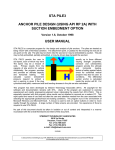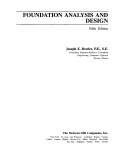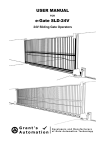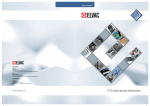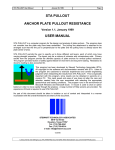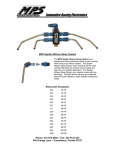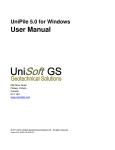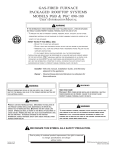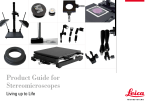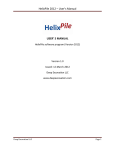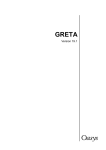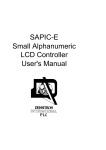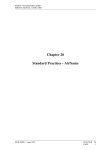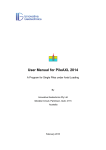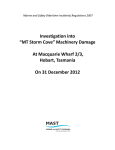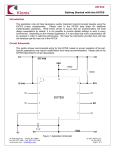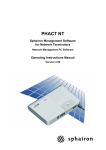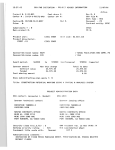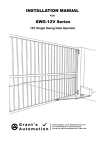Download STA PILE 3 INSTRUCTION MANUAL
Transcript
STEWART TECHNOLOGY ASSOCIATES www.stewart-usa.com - USA and Caribbean STA PILE3 USER MANUAL Version 1.8, December 2009 STA PILE3 ANCHOR PILE DESIGN (USING API RP 2A) WITH SUCTION EMBEDMENT OPTION Version 1.8, December 2009 USER MANUAL STA PILE3 is a computer program for the design and analysis of pile anchors. The piles are treated as being "short" with a free-head condition. The attachment point, or padeye for the mooring line may be at any point on the pile The pile may be driven into the sea bed or may be embedded by suction. The pile may be fully embedded, partially embedded, or may be driven deep beneath the sea bed. STA PILE3 permits the user to specify up to three different soil layers, each of which may have varying strength properties. The layers may be a mixture of cohesive and cohesionless soils. Primary results from the program provide the ultimate capacity of pile anchrs for vertical and horizontal loading. Additionally, the program provides factors of safety against failure and provides an ultimate capacity check for combined vertical and horizontal loading. The program may also be used to calculate suction embedment conditions. The differential pressure requred to embed a suction anchor is calculated and a warning is given if the plug inside the anchor will lift. For cylindrical steel piles, maximum axial and bending stresses in the pile are also calculated. This program has been developed by Stewart Technology Associates (STA). All copyright for the software and documentation remains with STA. Users of the program are cautioned to exercise experienced and careful engineering judgment when interpreting the results from STA PILE3. This is especially important with this program, since results can be obtained in seconds on a modern PC. This rapid speed and ease of use does not alter the care and attention needed from the user associated with selecting the appropriate geotechnical and loading conditions. The program runs in the environment of Microsoft Windows and Microsoft Excel. A mouse is used to click on option buttoms in order to move rapidly through the analysis. A large number of Help screens are provided. No experience of Excel is required to use STA PILE3. No part of this document should be taken in isolation or out of context and interpreted in a manner inconsistant with the overall framework and intent of this document. STEWART TECHNOLOGY ASSOCIATES 728 Bering Drive, Unit M Houston, Texas 77057 Tel: (713) 789-8341 Fax: (713) 583-2058 e-mail: [email protected] Last Revised December 9, 2009 STEWART TECHNOLOGY ASSOCIATES +1-713-789-8341 - [email protected] Page i STEWART TECHNOLOGY ASSOCIATES www.stewart-usa.com - USA and Caribbean STA PILE3 USER MANUAL Version 1.8, December 2009 EXTRACTS FROM LICENSE AGREEMENT LIMITATION OF USE This License is granted to the USER for an indefinite period. The USER agrees that no individual, outside consultant, government organization, or any person who is not on permanent staff with the USER or under direct in-house control of USER shall have access to the PROGRAM or shall use the PROGRAM for any purpose at any time. The use of the PROGRAM is not limited to a single machine, and the USER may make copies of PROGRAM and run it on several machines simultaneously. The USER agrees to make any reasonable effort to assure that the PROGRAM file or disk is not copied without authorization by OWNER, and that all users in USER's organization are familiar with these Limitations of Use. The USER agrees not to modify, copy, sell, lease, rent, give free of charge, or otherwise distribute or alter the PROGRAM or any part thereof to any individual, government agency, or organization outside of the USER organization. COPYRIGHTS All copyrights to the PROGRAM are reserved by OWNER. All versions of the PROGRAM are copyrighted by OWNER worldwide, beginning with 1991. The following is a trademark of OWNER: STA PILE3. The USER shall clearly and distinctly indicate the copyright in all published and public references to the PROGRAM. WARRANTY While the OWNER has carefully developed the software and the software has been tested for accuracy and proper functioning, nevertheless the OWNER cannot guarantee its accuracy and correctness. If the software fails to perform correctly as a result of errors or omissions by the OWNER or its staff, the OWNER will at its discretion rectify those errors and omissions free of all charges to the USER. This shall be the limit of the OWNER's liability in this respect. OWNER warrants that it has the right to grant this license. The PROGRAM and its documentation is sold "as is," and the USER assumes the entire risk as to quality and performance. HOLD HARMLESS The OWNER shall not be liable to the USER or any other party for any design, performance or other fault or inadequacy of the PROGRAM or its manual, or for any direct or implied damages of any kind arising out of or in any way related to or connected with any use of the PROGRAM. STEWART TECHNOLOGY ASSOCIATES +1-713-789-8341 - [email protected] Page ii STEWART TECHNOLOGY ASSOCIATES www.stewart-usa.com - USA and Caribbean STA PILE3 USER MANUAL Version 1.8, December 2009 Subject Page # Contents 1.0 INTRODUCTION ................................................................................................... 1 2.0 FAILURE MECHANISM ........................................................................................ 2 3.0 SPECIAL CONDITIONS AT PILE ANCHORS ....................................................... 4 4.0 PROGRAM INSTALLATION ................................................................................. 5 4.1 Introduction ........................................................................................................ 5 4.2 Install Files and Create Directories .................................................................... 5 4.3 Install Icon .......................................................................................................... 5 5.0 RUNNING THE PROGRAM .................................................................................. 7 6.0 GETTING HELP .................................................................................................... 9 7.0 BASIC ANALYSIS ASSUMPTIONS .................................................................... 13 7.1 Stiffness Factors .............................................................................................. 13 7.2 Vertical Loads .................................................................................................. 14 7.3 Ultimate Resistance To Horizontal Loading ..................................................... 16 Cohesive Soils ....................................................................................................... 16 Cohesionless Soils ................................................................................................. 16 Layered Soils ......................................................................................................... 17 Rotational Failure Calculations .............................................................................. 17 8.0 PILE STRESSES ................................................................................................ 19 REFERENCES .............................................................................................................. 20 APPENDIX 1 ................................................................................................................. 21 DEFINITION OF INPUT DATA .................................................................................. 21 Z1, thickness of upper soil layer (ft) ........................................................................... 22 Z2, thickness of middle soil layer (ft).......................................................................... 22 Z3, thickness of lowest soil layer, (ft) ......................................................................... 22 Phi1, 1st layer friction angle (deg.) ............................................................................ 22 Phi2, 2nd layer friction angle (deg.) ........................................................................... 22 Phi3, 3rd layer friction angle (deg.) ............................................................................ 22 cu1, undrained sh. strength top 1st layer (psf) ........................................................... 22 cu2, undrained sh. strength bottom 1st layer (psf) ..................................................... 22 cu3, undrained sh. strength top 2nd layer (psf) ......................................................... 22 cu4, undrained sh. strength bottom 2nd layer (psf).................................................... 23 STEWART TECHNOLOGY ASSOCIATES +1-713-789-8341 - [email protected] Page iii STEWART TECHNOLOGY ASSOCIATES www.stewart-usa.com - USA and Caribbean STA PILE3 USER MANUAL Version 1.8, December 2009 cu5, undrained sh. strength top 3rd layer (psf) .......................................................... 23 cu6, undrained sh. strength bottom 3rd layer (psf) .................................................... 23 Gamma1, 1st layer buoyant weight (pcf) ................................................................... 23 Gamma2, 2nd layer buoyant weight (pcf) .................................................................. 23 Gamma3, 3rd layer buoyant weight (pcf) ................................................................... 23 Fy, Yield stress for pile steel (ksi) .............................................................................. 23 ztop, top to seabed (-ve if buried) (ft) ......................................................................... 23 zc, dist.pile head to pad eye (ft) ................................................................................. 23 pile OD (in) ................................................................................................................ 23 t, pile wall thickness (inches) ..................................................................................... 24 E, Young's Modulus pile (psi) .................................................................................... 24 Hmax, applied lateral load (kip) ................................................................................. 24 Vmax, applied vert.load (+ve up) (kip) ....................................................................... 24 pile mass density (lb/cuft) .......................................................................................... 24 no. radial bulkheads................................................................................................... 24 pile top thickness (in) ................................................................................................. 24 cu reduction factor ..................................................................................................... 25 Suction embedment analysis ..................................................................................... 25 STEWART TECHNOLOGY ASSOCIATES +1-713-789-8341 - [email protected] Page iv STEWART TECHNOLOGY ASSOCIATES www.stewart-usa.com - USA and Caribbean 1.0 STA PILE3 USER MANUAL Version 1.8, December 2009 INTRODUCTION STA PILE3 is a program for the design and analysis of piles with a free-head condition. The program determines the ultimate capacity of the pile in response to a combination of vertical and horizontal loading. Being an ultimate capacity approach, the program does not consider deflection limitations. Those who wish to determine piles suited to conditions which must have limited deflections should use another approach. STA has programs for this and inquiries are welcomed. The general approach in STA PILE 3 is that of the API (Reference 1). The user may define up to three soil layers which may be either cohesive or cohesionless or with combined properties. The basic version of the program is set up to handle cylindrical steel piles and the user must specify the pile properties. These properties are yield stress, pile length, pile diameter, pile wall thickness, and Young's modulus for the steel. In addition to analyzing the capacity of installed piles, STA PILE 3 may be used to calculate the conditions associated with the installation of suction embedded piles. Suction embedded piles are installed by causing a differential pressure between the inside of the pile and the surrounding water. This differential pressure causes a net downwards force on the top of the pile. Under certain conditions, the pile will force itself into the sea bed. STEWART TECHNOLOGY ASSOCIATES +1-713-789-8341 - [email protected] Page 1 STEWART TECHNOLOGY ASSOCIATES www.stewart-usa.com - USA and Caribbean 2.0 STA PILE3 USER MANUAL Version 1.8, December 2009 FAILURE MECHANISM The general failure mechanism assumed by the program is for the pile to rotate about some point within its length as a consequence of the lateral load or to pull upwards as a consequence of the vertical component of load applied to the pile. These failure mechanisms are illustrated in Figure 1 below. In the case for a vertical pile unrestrained at the head subjected to a lateral load at the pile head, the lateral loading is initially carried by the soil close to the ground surface. As the load at the pile head is increased, the soil compresses elastically, but the movement is sufficient to transfer some pressure from the pile to the soil at greater depth. Eventually, the soil yields plastically and transfers loads to greater depth still. This program is for short "rigid" piles. Length to width ratios should be less than 12. At the ultimate capacity load (applied horizontally to the pile head) the pile will rotate and fail the soil plastically. A passive resistance develops above the toe on the opposite face of the pile adding to the resistance of the soil further up the pile towards the ground surface. Failure occurs when the passive resistance of the soil at the head and the toe are exceeded. STEWART TECHNOLOGY ASSOCIATES +1-713-789-8341 - [email protected] Page 2 STEWART TECHNOLOGY ASSOCIATES www.stewart-usa.com - USA and Caribbean STA PILE3 USER MANUAL Version 1.8, December 2009 FIGURE 1 STEWART TECHNOLOGY ASSOCIATES +1-713-789-8341 - [email protected] Page 3 STEWART TECHNOLOGY ASSOCIATES www.stewart-usa.com - USA and Caribbean 3.0 STA PILE3 USER MANUAL Version 1.8, December 2009 SPECIAL CONDITIONS AT PILE ANCHORS STA PILE3 is designed to take account of the special conditions associated with the design and analysis of pile anchors. Several important differences between pile anchors and free standing piles are noted here. First, the pile anchor is frequently buried beneath the sea bed. Second, the load applied to the pile anchor is generally from a mooring chain attached to the pile anchor by a pad eye. The pad eye may be some distance below the top of the pile anchor. Consequently, the pile anchor induces passive soil resistance above the point of load application as well as below the point of load application. The program accounts for the improved lateral resistance of fully buried pile anchors when the pad eye is at some distance beneath the top of the pile anchor. Unlike foundation piles for many offshore structures, that are generally long and slender, anchor piles are generally stocky, with comparatively slenderness ratios. API (Reference 1) and other design guidance documents/authorities generally recognise that the horizontal resistance of a long slender offshore structure foundation pile largely comes from the upper sea bed soils. The pull-out resistance, and the resistance to further embedment, largely comes from the soil around the lower half of the pile. Hence the two types of ultimate capacity can be treated virtually independently. In short stocky anchor piles this is inappropriate and combined failures are to be considered (rotation caused by horizontal loads and pull-out caused by vertical loads). STEWART TECHNOLOGY ASSOCIATES +1-713-789-8341 - [email protected] Page 4 STEWART TECHNOLOGY ASSOCIATES www.stewart-usa.com - USA and Caribbean 4.0 PROGRAM INSTALLATION 4.1 Introduction STA PILE3 USER MANUAL Version 1.8, December 2009 STA PILE3 is a computer program for the design and analysis of pile anchors. The latest release of the program (Version 1.9, December, 2009) runs in the environment of Microsoft Excel 2007, under Windows XP, Vista or Windows 7. The program is distributed as an Excel workbook with macros and some Visual Basic code. 4.2 Install Files and Create Directories STA PILE3 must be set up in sub-directory on your hard disk. Before installing STA PILE3, you must have Excel already installed on your hard disk. You must manually set up the necessary directory and copy the files over. 4.3 Install Icon Once the directory structure has been created and the program files have been copied from the distribution floppy diskette to the STAPILE sub-directory, you can set up the icon (see your Windows documantation, or simply right-click on your desktop and be intuitive). The STA PILE3 icon is shown to the right. STEWART TECHNOLOGY ASSOCIATES +1-713-789-8341 - [email protected] Page 5 STEWART TECHNOLOGY ASSOCIATES STA PILE3 USER MANUAL Version 1.8, December 2009 www.stewart-usa.com - USA and Caribbean STA PILE3 Anchor Pile Design (using API RP 2A) w/Suction Embedment v.1.7 March 2004 Run ref: Corocoro PLEM piles 5/3/2006 15:48 Copyright Stewart Technology Associates 1992 and onwards. For support telephone: (713) 789-8341, or fax: (713) 789-0314 Explain value Select Analysis Type and Apply Loads Assumptions Friction Print Input & Results Navy soil design parameters API Cohesionless soil design parameters INPUT DATA BELOW For pile top below sea bed make ztop negative. SOIL PROPERTIES (up to three layers) PILE PROPERTIES and ANALYSIS OPTIONS 45.00 Z1, thickness of upper soil layer (ft) soil-pile 35.00 Fy, Yield stress for pile steel (ksi) 5.00 Z2, thickness of middle soil layer (ft) friction 35.00 Lp, length (ft) 5.00 Z3, thickness of lowest soil layer (ft) angles 0.00 Phi1, 1st layer friction angle (deg.) 0 0.00 Phi2, 2nd layer friction angle (deg.) 0 30.00 Phi3, 3rd layer friction angle (deg.) 0 no. radial bulkheads 0.00 ztop, top to seabed (-ve if buried) (ft) 1 radial bulhead thickness (in) 3.00 zc, dist.pile head to pad eye (ft) 0 pile top thickness (in) 24.00 pile OD (in) 1 cu reduction factor 1.00 t, pile wall thickness (inches) 25 35.00 cu1, undrained sh. strength top 1st layer (psf) 490 pile mass density (lb/cuft) 2 Installed capacity analysis 29000000 E, Young's Modulus pile (psi) 2 1=closed end, 2=open 395.00 cu2, undrained sh. strength bottom 1st layer (psf) 35 Hmax, applied lateral load (kip) 2 cu_switch; 1=psi, 2=old API method 395.00 cu3, undrained sh. strength top 2nd layer (psf) 17 Vmax, applied vert.load (+ve up) (kip) 2 1=underconsol., 2=normal SUMMARY RESULTS 395.00 cu4, undrained sh. strength bottom 2nd layer (psf) 0.00 cu5, undrained sh. strength top 3rd layer (psf) 1.01 Horizontal load safety factor 0.00 cu6, undrained sh. strength bottom 3rd layer (psf) 3.14 Vertical load safety factor 77.00 Gamma1, 1st layer buoyant weight (pcf) 0.40 Unity stress check (app.loads) 77.00 Gamma2, 2nd layer buoyant weight (pcf) 1.61 Ult. capacity unity check (Meyerhof) 70.00 Gamma3, 3rd layer buoyant weight (pcf) Short pile criteria probably OK open DETAILED RESULTS Meyerhof unity check based on a safety factor of 1.5 35 Hult, ult.horiz. capacity in kips n/a n/a 53 Vult, ult.vert. capacity in kips n/a n/a 332 f, dist.top to rotation center (in) Rotation center shown as blue dot Pile Elevation n/a plug resistance (kips) -9.09 fb, max bend.str.from Hmax (ksi) 0.00 weight radial bulkheads (kips) 0.24 fa, max.ax.str.from Vmax (ksi) 0.00 weight of pile top (kips) 9.33 fmax, comb.str.applied loads (ksi) 7.48 pile weight in water (kip) 8.61 pile weight in air (kips) 64.00 (editable) density of sea water (lb/cuft) 1.39E+11 EI, for pile (lbf-in^2) 0.00 multiplier on base shear: 1=full, 0=none 13.43 T, rel.stiffness (avg. value) 4.79E+03 I, for pile in in^4 2.61 L/T, embed.length/stiff.factor, T 243 average skin friction (psf) 17.50 L/B, embedment length/pile OD -9.21 fb, max bending stress in pile in ksi from Hult 2 max +ve BM from Hult (ft-kip) 0.74 fa, max. axial stress in pile in ksi from Vult -306 max -ve BM from Hult (ft-kip) Explain value 9.95 max. combined stress in pile in ksi from ult. loads Select Analysis Type and/or Change Applied Loads Graphs below are based upon Hult applied to the pile, (not Hmax) Bending Moments Horizontal Shear Force -250 -200 -150 -100 -50 0 -40 50 -20 0 kip/ft 20 40 -8 60 0 0 100 100 100 200 200 200 300 400 300 400 Depth (in) 0 Depth (in) Depth (in) -300 Horizontal Soil Reactions Kips kip-feet -350 Explain value -6 300 400 500 500 500 600 600 600 700 700 700 FIGURE 2 User Area of Main Worksheet STEWART TECHNOLOGY ASSOCIATES +1-713-789-8341 - [email protected] Page 6 -4 -2 0 2 4 6 STEWART TECHNOLOGY ASSOCIATES STA PILE3 USER MANUAL Version 1.8, December 2009 www.stewart-usa.com - USA and Caribbean 5.0 RUNNING THE PROGRAM Once you have set up the program using the instructions in Section 4.0, you will be able to click on the STAPILE3 icon to start Excel and STA PILE3. The main spreadsheet (STAPILE3.XLS) will load. If you can see the button labeled Select Analysis Type and Apply Loads, simply click once on this button. You may need to maximize the spreadsheet. Do this by clicking once on the negative sign in the upper left hand corner of the spreadsheet. From the drop down menu that will appear, click once on Maximize. Your start up screen should then appear as shown in Figure 3. STA PILE3 Anchor Pile Design (using API RP 2A) w/Suction Embedment v.1.7 March 2004 Run ref: Corocoro PLEM piles 5/3/2006 15:48 Copyright Stewart Technology Associates 1992 and onwards. For support telephone: (713) 789-8341, or fax: (713) 789-0314 Explain value Select Analysis Type and Apply Loads Assumptions Friction Navy soil design parameters Print Input & Results API Cohesionless soil design parameters INPUT DATA BELOW For pile top below sea bed make ztop negative. SOIL PROPERTIES (up to three layers) PILE PROPERTIES and ANALYSIS OPTIONS 45.00 Z1, thickness of upper soil layer (ft) soil-pile 35.00 Fy, Yield stress for pile steel (ksi) 5.00 Z2, thickness of middle soil layer (ft) friction 35.00 Lp, length (ft) 5.00 Z3, thickness of lowest soil layer (ft) angles 0.00 Phi1, 1st layer friction angle (deg.) 0 0.00 Phi2, 2nd layer friction angle (deg.) 0 30.00 Phi3, 3rd layer friction angle (deg.) 25 35.00 cu1, undrained sh. strength top 1st layer (psf) 490 pile mass density (lb/cuft) 0 no. radial bulkheads 0.00 ztop, top to seabed (-ve if buried) (ft) 1 radial bulhead thickness (in) 3.00 zc, dist.pile head to pad eye (ft) 0 pile top thickness (in) 24.00 pile OD (in) 1 cu reduction factor 1.00 t, pile wall thickness (inches) 2 Installed capacity analysis 29000000 E, Young's Modulus pile (psi) 2 1=closed end, 2=open 395.00 cu2, undrained sh. strength bottom 1st layer (psf) 35 Hmax, applied lateral load (kip) 2 cu_switch; 1=psi, 2=old API method 395.00 cu3, undrained sh. strength top 2nd layer (psf) 17 Vmax, applied vert.load (+ve up) (kip) 2 1=underconsol., 2=normal SUMMARY RESULTS 395.00 cu4, undrained sh. strength bottom 2nd layer (psf) 0.00 cu5, undrained sh. strength top 3rd layer (psf) 1.01 Horizontal load safety factor 0.00 cu6, undrained sh. strength bottom 3rd layer (psf) 3.14 Vertical load safety factor 77.00 Gamma1, 1st layer buoyant weight (pcf) Explain value 0.40 Unity stress check (app.loads) 77.00 Gamma2, 2nd layer buoyant weight (pcf) 1.61 Ult. capacity unity check (Meyerhof) 70.00 Gamma3, 3rd layer buoyant weight (pcf) open Short pile criteria probably OK FIGURE 3 The spreadsheet will always contain values in every editable cell. It is recommended that following an analysis with the program, you save the spreadsheet before closing down the application. You should begin each new analysis by clicking on the button Select Analysis Type and Applied Loads. A dialog box will open in which you can select the type of analysis you wish to perform. The choices are Installed Pile Capacity Analysis or Suction Embedment Analysis. In this dialog box, you will also be able to define the loads to be applied to the pile in an installed pile capacity analysis. These loads will be retained in this dialog box and loaded into the worksheet each time you select the Installed Pile Capacity Analysis option. If you select to perform a suction embedment analysis, these loads will still be retained in the dialog box, but the horizontal applied load will be set to zero on the worksheet and the load necessary to cause suction embedment will be calculated as the vertical applied load. An example of how this dialog box looks is shown in Figure 4. STEWART TECHNOLOGY ASSOCIATES +1-713-789-8341 - [email protected] Page 7 STEWART TECHNOLOGY ASSOCIATES www.stewart-usa.com - USA and Caribbean STA PILE3 USER MANUAL Version 1.8, December 2009 FIGURE 4 Once you have set the analysis type, you may edit any of the cells in the input data section of the worksheet. A full description of the meaning of all the terms in this section of the worksheet is contained in Appendix A. Please note that the program uses iterative calculations to determine whether or not the pile is plugged if an open ended pile analysis is performed. As soon as you have selected the analysis type, the worksheet environment will be set within Excel to perform iterative calculations. While the iterative scheme is relatively robust, you may find that you can specify inappropriate input data which will cause the system to fail. The failure will be manifested by error messages occurring in Results cells. You should normally be able to rectify this situation by correcting your input data. However, it may be necessary to switch from a suction embedment analysis to an installed pile analysis and specify the pile to be closed ended. Once you have corrected your problems of inappropriate data input, the program should run successfully. STEWART TECHNOLOGY ASSOCIATES +1-713-789-8341 - [email protected] Page 8 STEWART TECHNOLOGY ASSOCIATES www.stewart-usa.com - USA and Caribbean 6.0 STA PILE3 USER MANUAL Version 1.8, December 2009 GETTING HELP In Figure 3, two of the buttons are labeled “Explain”. Highlight any data entry or results cell (by clicking on it once) and then click once on any “Explain” button. A dialog box will be flashed up onto the screen containing information regarding the selected cell. An example of this is shown in Figure 5. In this figure, the user has selected the input cell cu_switch. A dialog box has been brought up onto the screen describing what this input data selection "switch" does. FIGURE 5 Help is also available in interpreting the results. The main summary results for an installed pile analysis are seen in the lower right hand corner of Figure 2. In Figure 6 (an enlarged view of a section of Figure 2) it is seen that the ultimate capacity unity check results cell has been selected. The dialog box that appears when the “Explain” button is clicked is shown Figure 7 and explains the basis of this result. FIGURE 6 STEWART TECHNOLOGY ASSOCIATES +1-713-789-8341 - [email protected] Page 9 STEWART TECHNOLOGY ASSOCIATES www.stewart-usa.com - USA and Caribbean STA PILE3 USER MANUAL Version 1.8, December 2009 FIGURE 7 If the user selects a cell for which there is no help available, a dialog box will be flashed up on the screen, suggesting that the cursor is repositioned in another cell. An example of this is shown in Figure 8. FIGURE 8 Two tables of useful data are built into the program and can be viewed by clicking on the “API Cohesionless Soil Parameters” button or the “Navy Soil Design Parameters” button. The tables are shown in figures 9 and 10. STEWART TECHNOLOGY ASSOCIATES +1-713-789-8341 - [email protected] Page 10 STEWART TECHNOLOGY ASSOCIATES www.stewart-usa.com - USA and Caribbean STA PILE3 USER MANUAL Version 1.8, December 2009 FIGURE 9 STEWART TECHNOLOGY ASSOCIATES +1-713-789-8341 - [email protected] Page 11 STEWART TECHNOLOGY ASSOCIATES www.stewart-usa.com - USA and Caribbean STA PILE3 USER MANUAL Version 1.8, December 2009 FIGURE 10 STEWART TECHNOLOGY ASSOCIATES +1-713-789-8341 - [email protected] Page 12 STEWART TECHNOLOGY ASSOCIATES STA PILE3 USER MANUAL Version 1.8, December 2009 www.stewart-usa.com - USA and Caribbean 7.0 BASIC ANALYSIS ASSUMPTIONS The user can be reminded of the basic analysis assumptions when running the program by clicking once on the button assumptions. If a vertically downwards load is applied to the pile, the end bearing resistance of the pile will be calculated. 7.1 Stiffness Factors Although the program assumes that the pile behaves as a short rigid unit, a stiffness check is performed and a warning is issued if the pile appears to be too flexible compared to the soil stiffness for the case being analyzed. The program calculates an average stiffness factor for the pile based upon the stiffness of the pile (EI value) and the compressibility of the soil. The soil compressibility is expressed in terms of a soil modulus which is not constant for any soil type but depends upon the width of the pile and the depth of the particular loaded area of soil being considered. The soil stiffness is found by the program in terms of the coefficient of subgrade reaction, nh. The coefficient nh is determined for a user selected value of the ratio ymax divided by D, the pile diameter. The method used is that contained in the Navy Handbook For Marine Geotechnical Engineering (Reference 2.). For cohesionless soils, nh is obtained from Figure 5.3-2 in Reference 2. The program contains polynomial expressions which have been fitted to the four curves in this figure, each of which is for a different soil relative density (Dr). The relative density of the soil is estimated by the program based upon the friction angle of the soil specified for a particular layer by the user. The following selection criteria are used: If u < 5°, Dr = 35% If u < 20°, Dr = 50% If u < 30°, Dr = 65% If u < 45°, Dr = 85% If u > 45°, Dr = 85% For cohesive soils, nh is taken from Figure 5.3-3 in Reference 2. Polynomials are fitted to the two curves in that figure. The curve for soft clay is used if the average undrained shear strength for the clay is 1000 psf or less. The curve for stiff clay is used if the average undrained shear strength of the clay layer is greater than 1000 psf. For each soil layer, the value of Dr is computed and a value for the pile-soil relative stiffness, T, is computed by the equation: STEWART TECHNOLOGY ASSOCIATES +1-713-789-8341 - [email protected] Page 13 STEWART TECHNOLOGY ASSOCIATES STA PILE3 USER MANUAL Version 1.8, December 2009 www.stewart-usa.com - USA and Caribbean T = (EI/Nh)0.2 A weighted average for T is then computed for the embedded length of the pile based upon the individual values for T for each of the soil layers in which the pile is embedded. The value of pile length divided by soil stiffness is reported (L/T). If this value exceeds 3.5, a warning is given by the program to the user that the short pile criteria may be exceeded. This is a non-fatal warning and the program will still continue. 7.2 Vertical Loads Skin friction along the pile is calculated in each of the soil layers. API methods (Reference 1) are used. The shaft in cohesive soil layers, the shaft friction, f, is calculated by the equation 6.4.2-1 from Reference 1: f = ac Where a is a dimensionless factor and c is the undrained shear strength of the soil at the point in question. The factor, a, is computed by equation 6.4.2-2 from Reference 1: a = 0.5w-0.5 (for w < 1.0) a = 0.5w-0.25 (for w > 1.0) Both of the above equations have the contraint that a may not exceed 1.0. The variable, w, is equal to c/po for the point in question, where po is the effective overburden pressure at the point in question. The alternative method for determining pile vertical ultimate capacity described in the commentary to Reference 3 may also be used. If this method is desired, the user should set the input variable Cswitch to 1 and the shaft friction in cohesive soils will be calculated as follows: For C to be less than or equal to 1/4 ton/ft 2, F = C. For C in excess of 1/4 ton/ft2, but less than or equal to 3/4 ton per square foot, the ratio of F to C decreases linearlly from unity at C = 1/4 ton/ft2, to 1/2 at C = 3/4 ton/ft2. For C in excess of 3/4 ton/ft2, F is taken as 1/2 of C. Shaft friction in cohesionless soils is calculated by the method described in Reference 3. The shaft friction, f, is found from the equation: f = Kpotan d Where K is the coefficient of lateral earth pressure, p o is the effective overburden pressure and d is the friction angle between the soil and the pile wall. The value of K is taken to be 1 in the program as the pile is assumed to be closed end. The value of d is taken from Table 6.4.3-1 in Reference 3. The limiting values for f given in this table are also applied in STA PILE3. STEWART TECHNOLOGY ASSOCIATES +1-713-789-8341 - [email protected] Page 14 STEWART TECHNOLOGY ASSOCIATES www.stewart-usa.com - USA and Caribbean STA PILE3 USER MANUAL Version 1.8, December 2009 If the vertical component of loading applied to the pile is upwards, shaft friction on the outside of the pile only is considered. However, if the vertical loading is downwards, STA PILE3 considers internal shaft friction if the pile is specified as open ended, or the end bearing of the plug, whichever is less, as well as the end bearing of the pile wall annulus. If the pile is specified as closed end, the end bearing of the full cross section is calculated. The equations for end bearing are taken from API RP 2A (Reference 1) with coefficients and limiting values from Table 6.4.3-1 in this reference. The user of STA PILE3 is cautioned to use care in selecting the soil properties for analysis. The user is advised to consult Reference 1. The user can see a graph of skin friction down the pile by clicking once on the “Friction” button. An example is shown in Figure 11, below. FIGURE 11 STEWART TECHNOLOGY ASSOCIATES +1-713-789-8341 - [email protected] Page 15 STEWART TECHNOLOGY ASSOCIATES www.stewart-usa.com - USA and Caribbean 7.3 STA PILE3 USER MANUAL Version 1.8, December 2009 Ultimate Resistance To Horizontal Loading The method of Brinch Hansen is used to calculate the ultimate lateral resistance of the pile, inasmuch as the pile is divided into around 50 elemental lengths. This number varies depending upon whether the pile is completely buried or has any of its length above the soil. Each elemental length is treated as a rigid unit. The maximum passive resistance for each rigid unit, however, is not found using Brinch Hansen's coefficients, but is found using API coefficients (Reference 1). This section of the manual reproduces equations from API RP 2A, using the same equation numbers as in that document (Reference 1). Cohesive Soils The ultimate lateral bearing capacity, pu of clay is varied between 8c and 12c except at shallow depths where failure occurs in a different mode due to minimum overburden pressure. Cyclic loads caused deterioation of lateral bearing capacity below that for static loads. In stiff clays (c>2000 psf), more rapid deterioation under cyclic loading is expected, according to Reference 1. The following equations, taken from Reference 1 are implemented within STA PILE3. pu increases from 3c to 9c as X increases from 0 to XR according to: pu = 3c + X + J cX/D ......................................... (6.7.2-1) and pu = 9c for X XR ................................................ (6.7.2-2) where: pu c D J X = = = = = ultimate resistance, psi undrained shear strength for undisturbed clay soil samples, psi pile diameter, in. effective unit weight of soil, lb/in3 A value of .5 is appropriate for Gulf of Mexico clays, and is used in STA PILE3, although this can be user controlled if desired. = depth below soil surface, in. XR = D + J Cohesionless Soils The ultimate lateral bearing capacity for sand has been found to vary from a value at shallow depths determined by Eq. 6.7.6-1 to a value at deep depths determined by Eq. 6.7.6-2. At a given depth the equation giving the smallest value of p u should be used as the ultimate bearing capacity. STEWART TECHNOLOGY ASSOCIATES +1-713-789-8341 - [email protected] Page 16 STEWART TECHNOLOGY ASSOCIATES www.stewart-usa.com - USA and Caribbean STA PILE3 USER MANUAL Version 1.8, December 2009 pus = (C1 H + C2 D) H .............................(6.7.6-1) pud = (C3 D H ..............................................(6.7.6-2) where: pu = = H = ' = C1,, C2 C3 = D = ultimate resistance (force/unit length), lbs/in. (s = shallow, d = deep) effective soil weight, lb/in3 depth, in. angle of internal friction of sand, deg. Coefficients determied from figure 6.7.6-1 as function of '. average pile diameter from surface to depth, in. In STA PILE3, coefficients C1, C2, and C3 are determined based upon the user input angle of internal friction for the soil and by polynomial curve fits to Figure 6.7.6-1 in Reference 1. Note: All units for user input terms in STA PILE3 are converted to appropriate values for use in the equations described in this section. It is important that the user inputs values in the units shown in the input data section of the program. Layered Soils Up to three soil layers which may be mixed cohesive and cohesionless layers can be specified by the user in STA PILE3. In each layer, the above equations are implemented for each elemental length of the pile. Overburden pressure is calculated for buried cohesionless layers. Rotational Failure Calculations In order to calculate the failure mode of a pile anchor subject to horizontal loading, the unit passive resistance of each element of the pile at a depth Z below the ground surface is given by the equation: Pz = PozKqz + cKcz Where Poz is the effective overburden pressure at depth z, c is the cohesion of the soil at depth z, and Kqz and Kcz are the passive pressure coefficients for the frictional and cohesive components respectively at depth z. For each successive soil layer, the depth z is assumed to begin at the top of the soil layer in order to determine the appropriate coefficient K q or Kc. However, the effective overburden pressure is calculated from the top of the soil down to the depth of the layer in question. STEWART TECHNOLOGY ASSOCIATES +1-713-789-8341 - [email protected] Page 17 STEWART TECHNOLOGY ASSOCIATES www.stewart-usa.com - USA and Caribbean STA PILE3 USER MANUAL Version 1.8, December 2009 The total passive resistance on each horizontal element (dH) is given by the equation: dH = pzdHB The point of rotation of the pile is then found such that the summation of the passive soil resistance forces times their lever arms above the point of rotation balances the sum of the element passive resistances multiplied by their lever arms below the point of rotation. Having found the depth to the center of rotation from the above approach, the ultimate lateral resistance of the pile to a horizontal force is obtained by taking moments about that point of rotation. The program then constructs shearing force and bending moment diagrams. The bending moments, shear forces, and soil reaction diagrams are reported on the single page of output which would normally be printed by a user of the program. STEWART TECHNOLOGY ASSOCIATES +1-713-789-8341 - [email protected] Page 18 STEWART TECHNOLOGY ASSOCIATES www.stewart-usa.com - USA and Caribbean 8.0 STA PILE3 USER MANUAL Version 1.8, December 2009 PILE STRESSES Having found the bending moments in the pile, the program calculates bending stresses and reports the maximum bending stress in response to the ultimate horizontal load that the pile can resist. The program also reports the bending stress in response to the user specified applied horizontal load. Additionally, the program reports axial stresses in response to the vertical loads. The program determines the ultimate vertical (upwards) load that the pile can carry and the maximum axial stress that this will cause. It reports this value as well as the maximum axial stress in response to the user specified vertical load, as shown in Figure 12. FIGURE 12 STEWART TECHNOLOGY ASSOCIATES +1-713-789-8341 - [email protected] Page 19 STEWART TECHNOLOGY ASSOCIATES www.stewart-usa.com - USA and Caribbean STA PILE3 USER MANUAL Version 1.8, December 2009 REFERENCES 1. "Recommended Practice For Planning, Designing And Constructing Fixed Offshore Platforms", API Recommended Practice 2A (RP 2A) 19th Edition, August 1, 1991. 2. "Handbook For Marine Geotechnical Engineering", Technical Editor, Rocker, K. March 1985, available from Naval Civil Engineering Laboratory Port Hueneme, California 93043. 3. Meyerhof, G.G. and Ranjan, G., "The Bearing Capacity of Rigid Piles Under Inclined Loads in Sand, I: Vertical Piles", Canadian Geotechnical Journal, Vol. 9, 1972, pp. 430-446. STEWART TECHNOLOGY ASSOCIATES +1-713-789-8341 - [email protected] Page 20 STEWART TECHNOLOGY ASSOCIATES www.stewart-usa.com - USA and Caribbean STA PILE3 USER MANUAL Version 1.8, December 2009 APPENDIX 1 DEFINITION OF INPUT DATA This Appendix lists each of the input data terms that the user may edit. Note that by placing the cursor on any input data cell and clicking on the button, EXPLAIN VALUE, the User is presented with a dialog box containing a detailed description of the input data term. This Appendix provides a reference for each of these terms. STEWART TECHNOLOGY ASSOCIATES +1-713-789-8341 - [email protected] Page 21 STEWART TECHNOLOGY ASSOCIATES www.stewart-usa.com - USA and Caribbean STA PILE3 USER MANUAL Version 1.8, December 2009 Z1, thickness of upper soil layer (ft) This is the thickness of the first soil layer from the sea bed downwards. Units are feet. Z2, thickness of middle soil layer (ft) This is the thickness of the second soil layer beneath the sea bed. Units are feet. Note that a visual check on the input data is provided in the upper diagram on the main results page for the program entitled, Pile Elevation. Z3, thickness of lowest soil layer, (ft) This is the thickness of the lowest soil layer in the analysis. Units are feet. Note that if the bottom of the pile is defined as extending to a depth within the sea bed beneath the bottom of this lowest soil layer, the properties for the soil at the bottom of the layer will be extended to the bottom of the pile. The program will issue a warning if the pile extends below the bottom of the third layer specified by the User. Phi1, 1st layer friction angle (deg.) This is the friction angle to be used in the analysis for cohesionless soil in the first layer. Unis are degrees. If the first soil layer is cohesive, Phi1 should be specified as zero. The program will issue a warning if both cohesive and cohesionless properties are specified for any soil layer. Phi2, 2nd layer friction angle (deg.) This is the friction angle to be used in the analysis for the second soil layer. Comments as for Phi1 apply. Phi3, 3rd layer friction angle (deg.) This is the third layer friction angle. Comments as for Phi1 apply. cu1, undrained sh. strength top 1st layer (psf) This is the UNDISTURBED undrained shear strength for the soil at the top of the first layer, in other words, at the sea bed. Units are in pounds force per square foot. cu2, undrained sh. strength bottom 1st layer (psf) This is the UNDISTURBED undrained shear strength for the soil at the bottom of the first layer, in other words, at the sea bed. Units are in pounds force per square foot. The undrained shear strength is considered to vary in a linear manner between the top and bottom of each layer. cu3, undrained sh. strength top 2nd layer (psf) This is the undrained shear strength for the soil at the top of the second layer, in other words, at the sea bed. Units are in pounds force per square foot. STEWART TECHNOLOGY ASSOCIATES +1-713-789-8341 - [email protected] Page 22 STEWART TECHNOLOGY ASSOCIATES www.stewart-usa.com - USA and Caribbean STA PILE3 USER MANUAL Version 1.8, December 2009 cu4, undrained sh. strength bottom 2nd layer (psf) Comments as for cu2 apply. cu5, undrained sh. strength top 3rd layer (psf) Comments as for cu1 apply. cu6, undrained sh. strength bottom 3rd layer (psf) Comments as for cu2 apply. Note that if the pile is specified as being embedded with its bottom beneath the third soil layer, the soil strength and weight parameters at the bottom of the third layer will be continued downwards. Gamma1, 1st layer buoyant weight (pcf) This is the submerged, or buoyant weight of the soil in the first layer. Units are in pounds per cubic foot. Gamma2, 2nd layer buoyant weight (pcf) This is the submerged, or buoyant weight of the soil in the second layer. Units are in pounds per cubic foot. Gamma3, 3rd layer buoyant weight (pcf) This is the submerged, or buoyant weight of the soil in the third layer. Units are in pounds per cubic foot. Fy, Yield stress for pile steel (ksi) This is the yield stress for the pile material. This term is used in calculating a unity stress check for the pile, considering the combined effects of axial and bending stresses. ztop, top to seabed (-ve if buried) (ft) This is the distance of the pile top to the sea bed. Units are in feet. If the pile top is at the sea bed, this term will be zero. If the top of the pile is above the sea bed, this term will be a positive value. If the pile top is driven beneath the sea bed, this term will be negative. zc, dist.pile head to pad eye (ft) This is the distance, in feet, from the top of the pile to the pad eye. If the pad eye is at the top of the pile, this term will be zero. pile OD (in) This is the outside diameter of the pile specified in units of inches. STEWART TECHNOLOGY ASSOCIATES +1-713-789-8341 - [email protected] Page 23 STEWART TECHNOLOGY ASSOCIATES www.stewart-usa.com - USA and Caribbean STA PILE3 USER MANUAL Version 1.8, December 2009 t, pile wall thickness (inches) This is the thickness of the pile wall in inches. The pile is assumed to have uniform wall thickness throughout its length. All piles are modeled as uniform cylinders. E, Young's Modulus pile (psi) This is the Young's Modulus for the pile material. Units are in pounds force per square inch. A typical value for steel is 30,000,000 psi. A typical value for concrete is 3,500,000 psi. This term is used in calculating the relative pile-soil stiffness term (see below). Hmax, applied lateral load (kip) This is the horizontal applied load to the pad eye. Units are kips. This term is specified by the user in a dialog box which is activated by clicking on the button, Select Analysis Type and Apply Loads. Vmax, applied vert.load (+ve up) (kip) This is the applied vertical load at the pile pad eye. Units are kips. If the pile is to be analyzed for uplift capacity, this term will be positive. If the pile is to be analyzed for vertically downwards applied loads, this term will be negative. This term is input by the using by clicking on the button, Select Analysis Type and Apply Loads. Note that if the User has selected to analyze suction embedment, Hmax (see above) will be set to zero and Vmax will be set to the calculated load required to cause suction embedment. pile mass density (lb/cuft) This is the mass density of the pile material. Units are pounds mass per cubic foot. This term is used to calculate the submerged weight of the pile. no. radial bulkheads The User may specify as many radial bulkheads as desired. If the User specifies zero, there will be no radial bulkheads. If the User specifies a value a 2, the program will assume that there is a central vertical bulkhead extending across the diameter of the pile. If the User specifies 3, the program will calculate three radial bulkheads spaced as 120 degrees. If the User specifies 1, the program will assume that vertical stiffeners within the pile exist. For each of the radial bulkheads, or stiffeners, the program will calculate weight, increased tip resistance to penetration, and internal skin friction. pile top thickness (in) This term is the thickness of a top which the User may specify on the pile. Units are in inches. The top will contribute weight to the pile. The User may adjust the thickness to account for additional equipment on the top of a suction pile. The pile mass density is used in calculating the weight of the pile top. STEWART TECHNOLOGY ASSOCIATES +1-713-789-8341 - [email protected] Page 24 STEWART TECHNOLOGY ASSOCIATES www.stewart-usa.com - USA and Caribbean STA PILE3 USER MANUAL Version 1.8, December 2009 cu reduction factor This term is used to multiply the undisturbed undrained shear strength of each layer. A cu reduction factor of 0.5 means that the actual undrained strength of the soil used in resistance and pullout calculations will be 50% of that input by the User. A cu reduction factor of 0.75 means that the actual undrained shear strength of the soil will be 75% of that specified by the User. Suction embedment analysis In earlier versions of the program, this "switch" had to be set by the User. The term is now automatically set when the User clicks on the button, Select Analysis Type and Apply Loads. The User is given two options in a dialog box that will appear. The first option is to perform and installed analysis. The second option is to perform a suction embedment analysis. This term will be set to 1 if suction embedment is selected, or 2 if installed analysis is selected. If it is desired to determine the penetration resistance of a driven closed ended pile, this "switch" should be set to 1. Where a closed ended pile is specfied, the analysis will assume that the pile is filled with water, both during driving and during pullout resistance calcuations. If the User specifies an closed ended pile by setting this "switch" to 1 and then selects to perform a suction embedment analysis, the program will issue a warning. In the psi method ( ), the friction force is: This term is a selection switch which sets alpha = 1.0 in the calculation of pile skin friction using the API RP 2A (19th Edition) psi method. This effectively sets f = cu which is appropriate for underconsolidated.. STEWART TECHNOLOGY ASSOCIATES +1-713-789-8341 - [email protected] Page 25





























